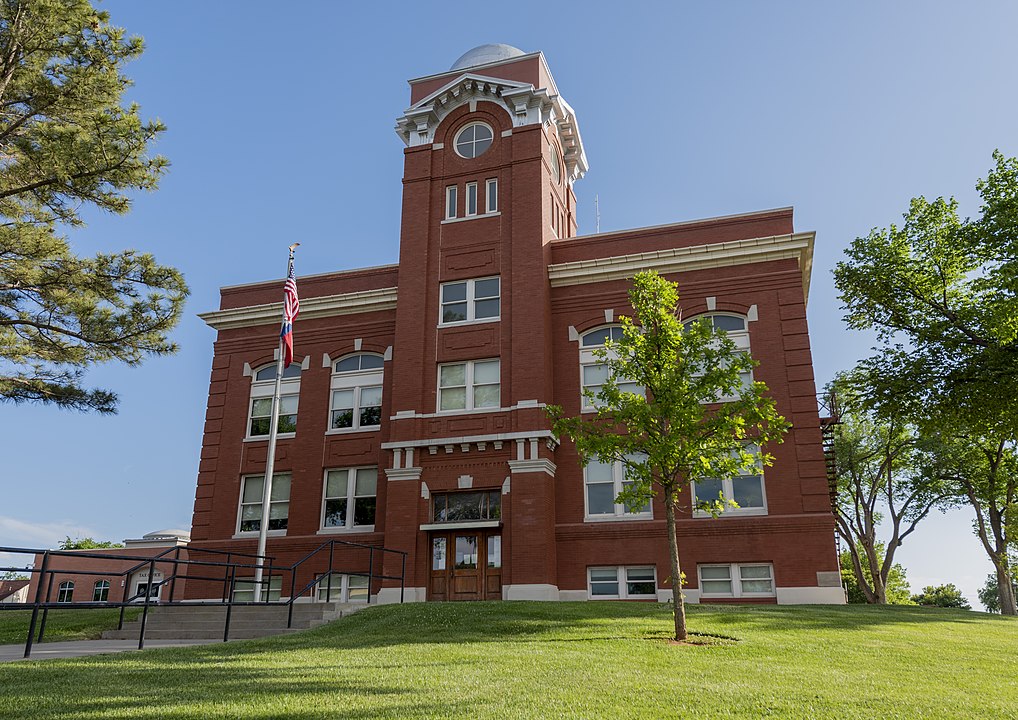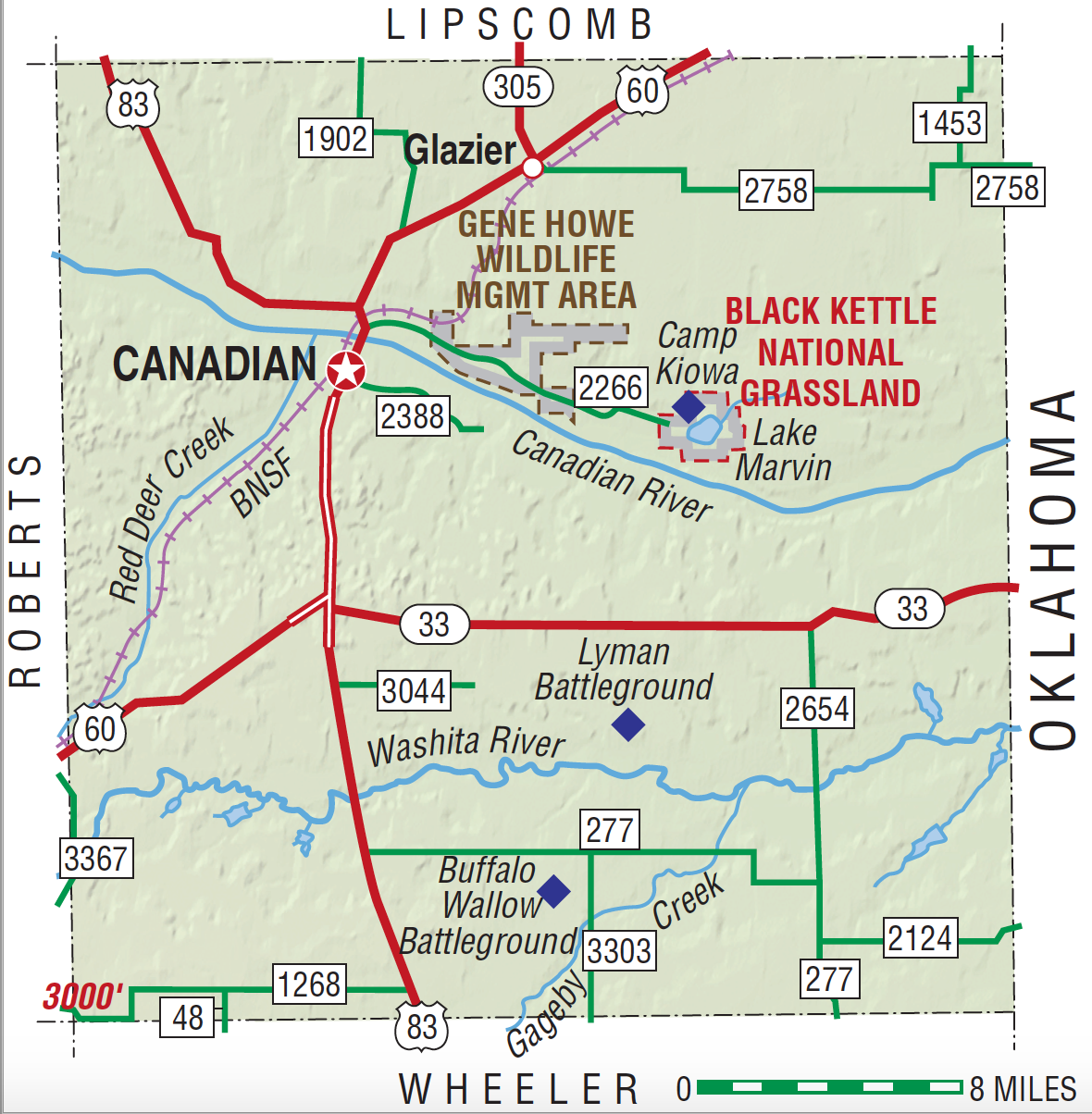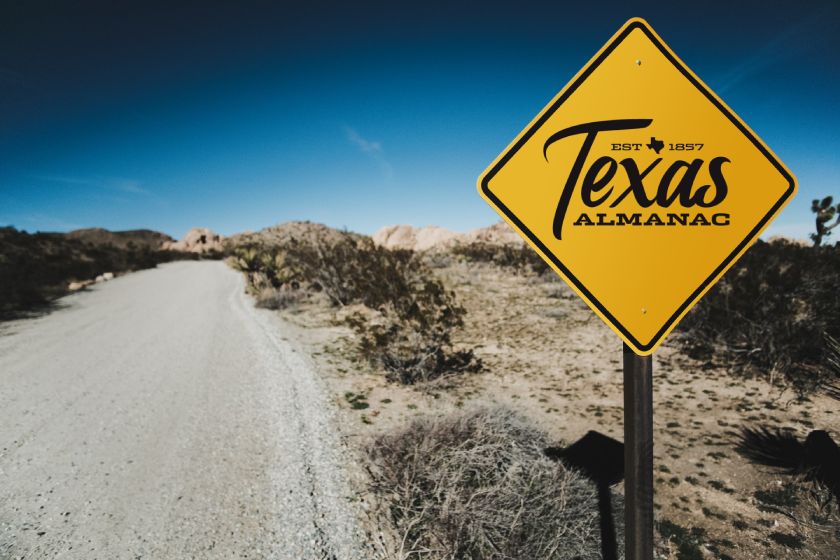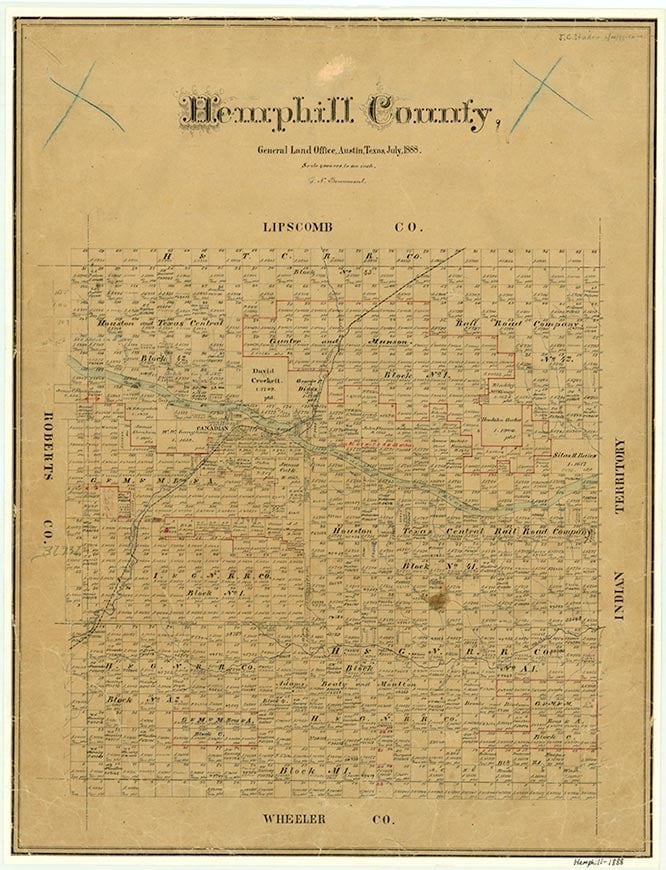Hemphill County

Hemphill County, Texas

Hemphill County, Texas
Hemphill County lies in the rolling plains on the eastern edge of the Panhandle, east of the Texas High Plains. It is bordered on the east by Oklahoma, on the south by Wheeler County, on the west by Roberts County, and on the north by Lipscomb County. The center point of the county is at 35°50' north latitude and 100°15' west longitude. Canadian, the county seat, is eight to ten miles northwest of the center of the county and about 120 miles northeast of Amarillo. The county was named for John Hemphill. It comprises 904 square miles of rolling plains and rugged terrain, broken by two major rivers and dozens of creeks. The Canadian River flows easterly across the north central part of the county, and the Washita River flows west to east across the southern part. Red Deer Creek is the major tributary of the Canadian in the county; Gageby Creek is the largest county tributary of the Washita. More than three dozen smaller creeks drain into the two rivers. The elevation ranges from 2,200 to 2,800 feet above sea level. The county's clay loam, sandy loam, and alluvial soils support a variety of native grasses as well as wheat, grain sorghum, hay, and other cultivated grass crops. Some cottonwood and elm trees can be found in the numerous creekbottoms. Oil and natural gas also contribute to the local economy; oil production in 2000 was more than 505,000 barrels. The average annual rainfall is 20.5 inches, and the growing season averages 204 days a year; the average maximum temperature is 95° F in July, and the average minimum is 23° in January.
The Hemphill County region was originally populated by Apaches, who were pushed out by the early 1800s by the Kiowas and Comanches. During the era of Indian control various European expeditions penetrated the region. That of Francisco Vásquez de Coronado possibly crossed the county in 1543 or 1544. The Long expedition, an American venture, certainly crossed the county in 1820, as did Josiah Gregg in 1839. Capt. Randolph B. Marcy surveyed several routes to California in 1849, including one that crossed Hemphill County along the divide between the Canadian and Washita rivers. During the 1870s buffalo hunters entered the Panhandle, and by 1878 the last of the great southern herd had been killed. At the same time, the Indians were crushed and moved to reservations in Indian Territory. In the Red River War of 1873–74 the United States Army defeated the Comanches and Kiowas in their Panhandle refuge. Several military encounters occurred in Hemphill County, including the famous Buffalo Wallow Fight, which took place in the southern part of the county on September 12, 1874. The defeated Indians were forced into Indian Territory in 1875 and 1876.
Donald R. Abbe | © TSHA

Adapted from the official Handbook of Texas, a state encyclopedia developed by Texas State Historical Association (TSHA). It is an authoritative source of trusted historical records.

- ✅ Adoption Status:
- This place is available for adoption! Available for adoption!
- Adopted by:
- Your name goes here
- Dedication Message:
- Your message goes here
Currently Exists
Yes
Place type
Hemphill County is classified as a County
Altitude Range
2170 ft – 3000 ft
Size
Land area does not include water surface area, whereas total area does
- Land Area: 906.3 mi²
- Total Area: 912.2 mi²
Temperature
January mean minimum:
21.2°F
July mean maximum:
93.2°F
Rainfall, 2019
21.8 inches
Population Count, 2019
3,819
Civilian Labor Count, 2019
1,711
Unemployment, 2019
5.1%
Property Values, 2019
$1,840,163,280 USD
Per-Capita Income, 2019
$58,484 USD
Retail Sales, 2019
$30,842,289 USD
Wages, 2019
$36,011,225 USD
County Map of Texas
Hemphill County
- Hemphill County
Places of Hemphill County
| Place | Type | Population (Year/Source) | Currently Exists |
|---|---|---|---|
| Town | – | – | |
| Town | 2,248 (2021) | Yes | |
| Town | – | – | |
| Town | – | – | |
| Town | – | – | |
| Town | – | – | |
| Town | – | – | |
| Town | 0 (2021) | Yes | |
| Town | – | – | |
| Town | – | – | |
| Town | – | – | |
| Town | – | – | |
| Town | – | – | |
| Town | – | – | |
| Town | – | – | |
| Town | – | – | |
| Town | – | – | |
| Town | – | – | |
| Town | – | – | |
| Town | – | – | |
| Town | – | – |

Proud to call Texas home?
Put your name on the town, county, or lake of your choice.
Search Places »

